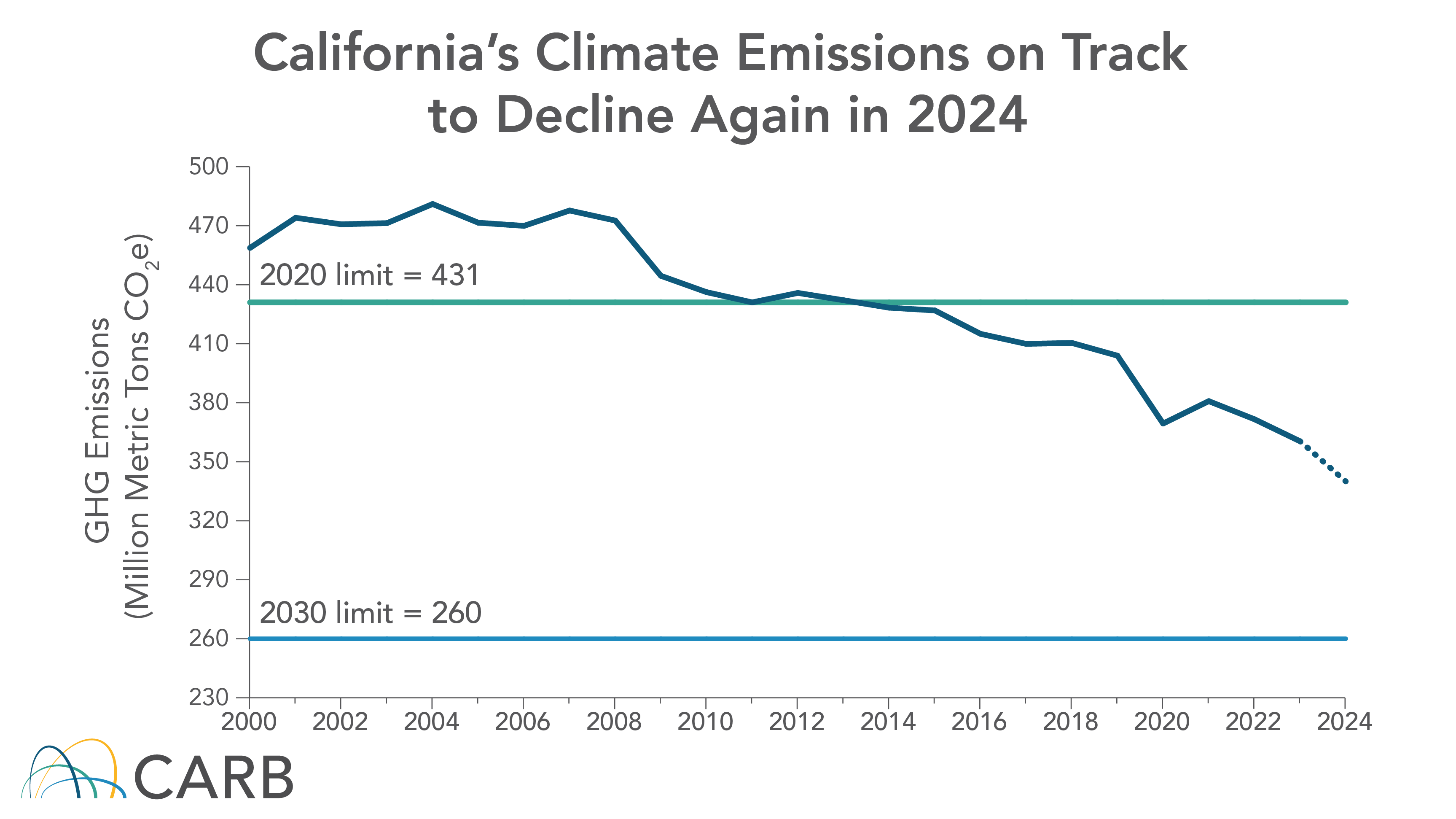Clean transportation drove California’s emissions drop in 2023
Contacts
What you need to know: The latest data shows California’s climate programs continue to push greenhouse gas (GHG) emissions down while the state’s economy grows, and they highlight the need to continue to make progress despite an unprecedented federal assault on the state's clean air efforts.
SACRAMENTO – The latest edition of the California's greenhouse gas emissions inventory (//ww2.arb.ca.gov/ghg-inventory-data) shows a three percent drop in statewide emissions – the third largest annual percentage decrease since the pandemic. The decrease is equivalent to removing more than 2.6 million gasoline-powered cars from California’s roads for one year.
“Today’s milestone once again confirms that bold climate action can deliver real results,” said California Air Resources Board Chair Lauren Sanchez. “California’s climate pollution is falling even as our economy grows — a powerful testament to the strength of our programs, innovation in clean technology, and the commitment of communities across the state. We’re not just investing in a healthier future, we’re actively building it."
The drop was primarily driven by reductions from the transportation sector, specifically a dramatic 17 percent decline from heavy-duty trucks due to the increased use of biofuels driven by the state’s Low Carbon Fuel Standard (LCFS). Renewable diesel and biodiesel accounted for 56% of the diesel used on-road in 2023.
The latest data underscores a continued trend of steady emissions decline even as the economy continues to grow. From 2000 to 2023, GHG emissions fell by 21 percent while California’s gross state product increased by 81 percent, pointing to the effectiveness of the state’s climate change and air quality programs.

“The latest data show that science-driven policy and innovation are moving California closer to our climate goals,” said California Environmental Protection Secretary Yana Garcia. “Emissions are down; cleaner trucks are on the road and communities are breathing healthier air. Access to reliable data isn't just the foundation of progress. It’s how we hold ourselves accountable and make smart choices for the future. As the Trump Administration moves to weaken national emissions reporting, California will continue to lead with transparency, integrity and results.”
An early estimate of 2024 data, based primarily on reported and third-party verified data for the state's largest emitters, shows that the downward trend will continue. The 2024 inventory data is not yet final and will not be released until 2026 once all data sources are updated and incorporated.

Highlights from the report
- Emissions from cars and light-duty pickup trucks dropped to their lowest levels ever — excluding the anomaly of 2020 during the COVID-19 pandemic —as fossil fuel use continued to decline.
- This drop occurred despite a one percent increase in vehicle miles travelled. Emissions from the state’s heavy-duty diesel vehicles also declined.
- California has decreased the carbon intensity of its economy by 57 percent since 2000.
- The electricity sector had its lowest carbon intensity since 2000. Wind and solar represent over 30 percent of generation and in-state solar increased by 8 percent from 2022, driven by requirements under the state’s Cap-and-Invest Program, also known as Cap-and-Trade and the Renewables Portfolio Standard.
- Industrial sector emissions declined by 5 percent due to reductions from refineries, oil and gas extraction, cement manufacturing, cogeneration facilities, and other fossil-fuel use.
- Livestock emissions, which are responsible for 71 percent of agriculture’s greenhouse gas emissions, peaked in 2012 and continued to decline in 2023. The decrease is driven by use of methane digesters at dairies funded by Cap-and-Invest auction money and incentivized by the Low Carbon Fuel Standard.
The residential and commercial sector had a rise in emissions, largely because of an increase in residential fossil gas use which was likely due to a colder winter in 2023.
About the inventory
The statewide inventory relies on data from the Mandatory Reporting Regulation, which counts emissions and reductions from about 80 percent of California’s sources of human-caused climate emissions. It uses data from other state and local agencies to round out that picture.
The announced plans to end federal monitoring of greenhouse gases will not affect California’s inventory.
California continues to stand up for science and act on climate
Illegal federal attempts to derail California’s clean vehicle standards will have some impact on the state’s ability to reduce the negative health and environmental impacts of climate change. But California remains committed to addressing harmful pollution and the impacts of climate change. This includes:
- Moving forward on the next round of light-duty vehicle emissions standards for the 2030s and beyond. A workshop was held on October 21 (//ww2.arb.ca.gov/events/public-workshop-drive-forward-light-duty-vehicle-program).
- Amending the state’s Cap-and-Invest Program to help achieve carbon neutrality by 2045. A workshop was held on October 29 (//ww2.arb.ca.gov/our-work/programs/cap-and-trade-program/cap-and-trade-meetings-workshops).
- Formalizing rules for carbon management. A nationwide list of carbon capture, utilization, and storage projects was posted last month (//ww2.arb.ca.gov/ccus-and-cdr-project-list) and rulemaking is expected to be finalized next year.
- Updating the Landfill Methane Regulation to reduce emissions from solid waste landfills. The Board will consider adopting the amendments on November 20 (//ww2.arb.ca.gov/rulemaking/2025/landfill-methane-regulation-0).
- Finalizing rules for corporate emissions reporting which requires companies to publish biennial climate-related financial risk reports. The Board is expected to consider an initial rulemaking early next year.
